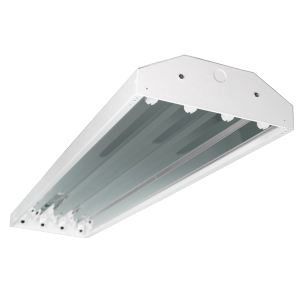Benefits of T5 HO High Bays
 For far too long, the standard for lighting warehouses, industrial facilities, manufacturing facilities and other high ceiling height applications has been the 400-Watt Metal Halide fixture. Advances in ballast technology and the improvements of the T5 High Output (T5 HO) Linear Fluorescent lamp have led to many new light fixtures that are targeted specifically to replace old HID high bays.
The following article details the many benefits that the T5HO high bay fixture offers over traditional 400 Watt Metal Halide high bays. These include energy efficiency, improved lumen maintenance, instant start, more usable and better quality light and improved color characteristics. To find out if T5 HO high bay fixtures are the best choice for your application, don't hesitate to contact us.
For far too long, the standard for lighting warehouses, industrial facilities, manufacturing facilities and other high ceiling height applications has been the 400-Watt Metal Halide fixture. Advances in ballast technology and the improvements of the T5 High Output (T5 HO) Linear Fluorescent lamp have led to many new light fixtures that are targeted specifically to replace old HID high bays.
The following article details the many benefits that the T5HO high bay fixture offers over traditional 400 Watt Metal Halide high bays. These include energy efficiency, improved lumen maintenance, instant start, more usable and better quality light and improved color characteristics. To find out if T5 HO high bay fixtures are the best choice for your application, don't hesitate to contact us.
Content Links
Energy Efficiency
With the rising cost of energy, facilities and operations managers are doing everything possible to lower total power consumption. One of the main reasons many companies turn to T5HO high bay fixtures when retrofitting their lighting system is the T5’s ability to provide better light while consuming less energy than traditional 400 Watt metal halide fixtures. T5HO fluorescent lamps consume 54 Watts of power and output up to 5,000 lumens per lamp. Typical 4-lamp fixtures consume as little as 218 Watts vs. the 454 Watts that a 400-Watt metal halide consumes. In most cases, maintained foot -candle readings are almost always better per energy dollars spent. The following chart demonstrates the relative efficacy of various sources of lights measured in lumens per watt.| Light Source | Conventional Lumens per Watt |
| Low-pressure sodium | 165 |
| 5000K T5 fluorescent | 104 |
| 4100K T8 fluorescent | 90 |
| Clear metal halide | 85 |
| 5000K pure triphosphor fluorescent | 70 |
| 3500K triphosphor fluorescent | 69 |
| 50 Watt high-pressure sodium | 65 |
| 2900K warm white fluorescent | 65 |
| Daylight fluorescent | 55 |
| 35 Watt high-pressure sodium | 55 |
| Deluxe mercury vapor | 40 |
| Standard incandescent | 15 |
| Tungsten halogen | 22 |
Lumen Maintenance
All lamps have some depreciation of the light output as they age. T5 fluorescent lamps only lose 5-6% of their lumen output between the rated initial spec and the mean spec. By contrast, Metal Halide lamps can have as much as 45% or more depreciation of lumen output during the same time period. This difference becomes more pronounced as the lamps continue to age.No Strike/Re-strike Delay
HID lamps require some time to turn on. This is called the strike time. If the lamps have been on for some time and power is cut off, they would also need time to re-strike. Fluorescent lamps however, turn back on in a little over 1 second without affecting the rated life of the lamp. This allows them to be used with occupancy sensors, photo cells and advanced lighting control systems that can further reduce operating costs by turning off the fixture when not in use. Modern T5HO ballasts also allow for multiple switch legs that can individually control the pairs of lamps in a fixture. These can be wired into separate circuits or control systems to allow for dimming options.More Usable Light
A linear fluorescent lamp shines light out radially in every direction from the center of the tube. Light that is cast out of the top of the lamp towards the fixture bounces off of the reflector and comes back towards the work plane. For larger T12 and T8 lamps, the size of the tube prevents most of this light from reaching the work plane because it bounces back to the tube. Since T5 tubes are extremely thin (only 5/8” diameter), more light can exit the fixture. This leads to more efficient fixtures and less shadows.Better Color Rendition
Color rendition index (CRI) is the measure of the ability of a light source to reproduce the colors of various objects faithfully in comparison with an ideal or natural light source. T5 lamps have a CRI of 85 while metal halide lamps, on the other hand, have a CRI of 65-70. The lower CRI negatively impacts visual acuity and can strain the eye. The following table provides a comparison of the CRI for several light sources.| Lamp Type | CRI |
| T5 Fluorescent | 85-98 |
| T8 Fluorescent | 75-98 |
| High color-rendering metal halide | 80-93 |
| White high-pressure sodium | 60-85 |
| Standard metal halide | 60-70 |
| Pulse-start metal halide | 65-70 |
| High-pressure sodium | 27 |
| Low-pressure sodium | 5 |
Color Temperature
Modern fluorescent lamps are available in a wide variety of color temperatures. These range from 3000K to 6500K. Specialty lamps extend the spectrum even more to suit specific purposes.Consistent Color Output
Fluorescent lamps maintain a more uniform color output throughout their life. Metal Halide or other HID sources can have their output color shift as the lamps age.March 17, 2010






